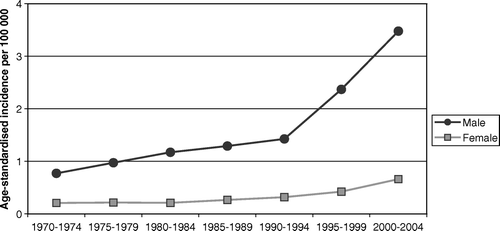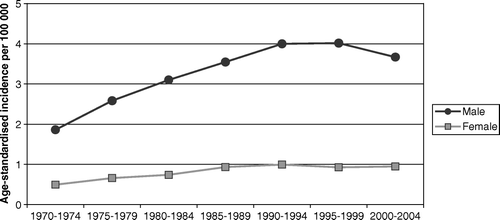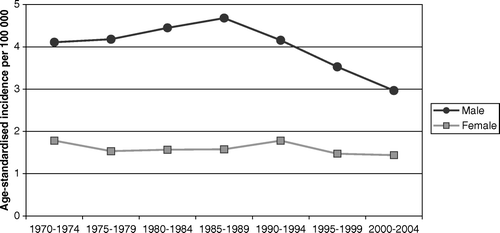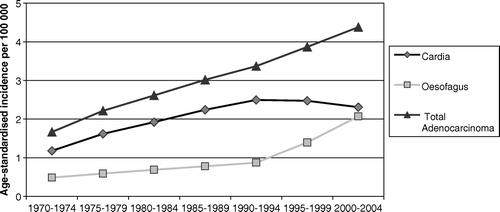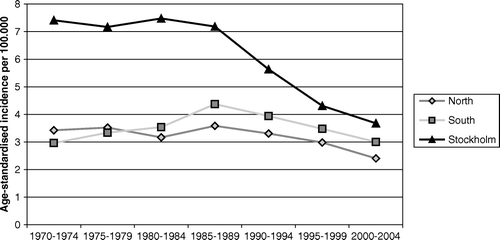Abstract
Background. The incidence of adenocarcinoma of the oesophagus is rising in many western countries including Sweden. Methods. We have studied the latest data concerning this as well as trends in the incidence of squamous cell carcinoma and adenocarcinoma of gastric cardia. Data was extracted from the Swedish cancer registry and analyzed regarding gender, age, region, histology and location of tumour. Results. The results show an increasing incidence of adenocarcinoma in both oesophagus and gastric cardia. Squamous cell carcinomas show a more stable development with a slight decrease of incidence. Adenocarcinoma is now the most common histological type of cancer in the oesophageal/cardia region in Sweden. Results also suggest a possible drift in location of adenocarcinoma from gastric cardia towards oesophagus. Overall a higher incidence was found in the male population and no trends in patient age at onset could be found. Squamous cell carcinoma is still slightly more common in urban regions.
Squamous cell carcinoma has long been the most common histological form of cancer in the oesophagus. For the last decade reports have shown a rising incidence of oesophageal adenocarcinoma in most of the western world, Citation[1–3] although unchanged in Asia Citation[4] and South America Citation[5], Citation[6]. Cancer of the oesophagus is rare representing only 0.8% of all new cases of cancer in Sweden 2004 (male: 1.1% and female: 0.4%) Citation[7]. Cancer of the cardia is almost always adenocarcinoma and represented 0.4% (male 0.6% and female 0.2%). The 5-year survival rate of oesophageal cancer is often described to be around 5% although reports indicate that an increase to nearly 10% is observed in Sweden Citation[8]. Earlier studies in Sweden have shown an increase in incidence of both histological types of oesophageal carcinomas, particularly in men Citation[9]. The etiology of the continuous increase of adenocarcinoma of the oesophagus has been the focus of many studies Citation[10–12]. Overweight, Barrett's oesophagus, dysplasia and tobacco smoke are some reported risk factors as well as low socioeconomic status. Selenium, dietary fibre, fruits and vegetables and antioxidants are seen as protective factors. Male gender seems to be a risk factor for both types of tumours in the region. Infection with human papilloma virus (HPV) does not seem to play a major part in the development of oesophageal cancers. Infection with Helicobacter pylori is however an interesting factor to this region of tumours as discussed in many reports Citation[13], Citation[14]. It has been suggested that infection with H. pylori is protective to adenocarcinoma but might be a risk factor for squamous cell carcinoma, although the role of H. pylori in the etiology of these cancers remain somewhat unclear. The anatomic region of these tumours is also of interest. Not only are there disparities in the classification of oesophageal and cardia tumours, Citation[15] the adenocarcinomas of the distal oesophagus, Siwert type I, and gastrooesophageal junction, Siwert type II, show different epidemiological profiles Citation[16]. It is still unclear if this is one disease in two locations or two different diseases altogether. Numerous questions arise concerning the epidemiological profile of these tumours and the Swedish national cancer registry offers unique opportunities to study these methodically. The aims of this study were to describe the latest trends in incidence of adenocarcinoma and squamous cell carcinoma of the oesophagus and gastric cardia, to determine if differences between genders exist and to investigate geographic differences particularly between rural and urban parts of the population.
Material and methods
The Swedish cancer registry started in 1958 and it is mandatory for clinicians and pathologists to send information on every new case of malignancy regarding personal identification number, sex, hometown, date of diagnosis and morphological diagnosis. Ninety nine percent of all cases are verified morphologically and the number of cases never reported is very low. This can be verified comparing data with the registry for cause of death. Data from the Swedish cancer registry have been extracted with regards to a number of coded variables according to the international classification of diseases for oncology (ICD-0), which also allows more detailed information on e.g. morphology. Localisation of tumours: oesophagus (150) and cardia (1511). Type of tumour: adenocarcinoma (096), squamous cell carcinoma (146) and others consisting of non-differentiated cancer (196) and unknown histology (996). The data separates males and females and range from 1970 to 2004. The material is also separated regarding the 21 different administrative regions of Sweden. These regions were combined into three groups. North (including Norrbottens län, Västerbottens län, Jämtlands län, Västernorrlands län, Gävleborgs län and Dalarnas län), South (including Uppsala län, Södermanlands län, Östergötlands län, Jönköpings län, Kronobergs län, Kalmar län, Gotlands län, Blekinge län, Hallands län, Värmlands län, Örebro län, Västmanlands län, Skåne län and Västra götalands län) and one group consisting only of Stockholms län, the region with the highest density of urban inhabitants in Sweden.
Statistical method
To minimize the effects of differences in the age composition, age-standardised incidence per 100 000 is used as standard throughout this paper. Directly age standardized incidence rates were calculated using the Swedish population 2000 as standard. The average annual change and corresponding 95% confidence intervals were estimated using a linear regression model were the logarithm of the yearly age-standardized figures was related to a linear trend term. Patients were grouped in 5-year intervals with an average incidence calculated for each group.
Results
A total of 17 454 patients with oesophageal or cardia cancer were registered in Sweden between 1970 and 2004 with an average of 499 new cases per year (360 men and 139 women).
The incidence of adenocarcinoma of the oesophagus is increasing continually from 1970 to 2004 (). For the total period the average annual increase is 4.9% (CI 95: 4.1–5.8) for men and 3.9% (CI 95: 2.7–5.0) for women. The increase is most prominent in the last 15 years and among men with an almost 10% annual increase in incidence. The average annual incidence among men in the period 1970–1974 was 0.77 and 2000–2004 it had increased almost 4.5 times to 3.48. For women the average increased 3.1 times, from 0.21 to 0.66. There is 5:1 greater incidence of adenocarcinoma of the oesophagus for men than women with little change of this ratio over time.
The incidence of adenocarcinoma in gastric cardia also increased during this period but with a different curve (). The average annual increase for men is 2.3% (CI 95: 1.8–2.9) and for women 2.1% (CI 95: 1.4–2.8). Comparing 1970–1974 with 2000–2004 the incidence has increased 2.0 times for men and 1.9 times for women although since 1990 the increase has been more or less stable both for men and women. A small decrease can however be seen among males in the last years but not statistically significant. The male predominance regarding the incidence of adenocarcinoma in gastric cardia is 4:1 with no change over time.
The incidence of squamous cell carcinoma of the oesophagus has been relatively stable from 1970 until about 1990 (). After 1990 it tends to decrease, especially among men. For the period 1970 to 2004 the average annual change in incidence for men was −1.0% (CI 95: −1.5 to −0.5) and for women −0.4% (CI 95: −0.9 to +0.1). If comparing 1985–1989 with 2000–2004 one can observe a marked decrease of the average incidence, especially among men. The incidence of squamous cell carcinoma in gastric cardia is higher for males by a 5:2 ratio with only small variations over time.
As mentioned above there are potential misclassifications between adenocarcinomas of the distal oesophagus and gastro-oesophageal junction (cardia). To eliminate this problem we compiled all the corresponding data of adenocarcinoma in the combined region () and found a rather linear and steady increase. The same pattern emerged in both gender.
Since 1970 the incidence of non-differentiated cancer types or unknown of the oesophagus decreased from 2.2 to 0.7 although in the last 15 years it has been stable. 2000–2004 only 8% of all cancers of the oesophagus were other than the two major histological types.
Patient median age group at onset was 70–74 years for both histological types and both gender with the exception of a tendency for a slightly higher age among women with adenocarcinoma. This median age at onset did not change during the observed 35 years in any of the sub groups.
There are no major differences in incidence of adenocarcinoma between the geographical parts of Sweden used in this paper ().
Figure 5. Incidence of adenocarcinoma of the oesophagus and cardia in both male and female in different geographical parts of Sweden.

Squamous cell carcinoma of the oesophagus was more common in the urban region of Stockholm compared to the rest of Sweden. During the observed 35 years the incidence of squamous cell carcinoma decreased 2.4% (CI 95: 3.1–1.8) in males in Stockholm (). No change was noted for women. Looking at the rest of Sweden without Stockholm a statistical change was notable in the north of Sweden for both men and women with a decrease of 0.9% and 1.7% respectively but no corresponding changes were found in the south. If comparing the region of Stockholm to the rest of Sweden the difference in incidence of squamous cell carcinoma is about 5:3. We found a tendency for this difference to decrease over time but not statistically significant.
Discussion
The incidence of adenocarcinoma in the oesophagus is increasing in Sweden, as can be seen throughout many western countries. There are of course differences in the rate of increase between various countries with no increase at all in some parts of Europe where as U.S. shows the highest rate Citation[1–3]. The incidence of squamous cell carcinoma in Sweden is decreasing for men and is fairly stable for women, which concurs with reports from countries throughout Europe where the incidence have been reported to be relatively stable with a tendency among men for rates to decline where as for women it is stable and in some countries even increasing.
Between 2000 and 2004, adenocarcinoma became the most common histological type of cancer in the oesophagus among Swedish men. In the last 15 years there have been an almost 10% annual increase in incidence of adenocarcinoma of the oesophagus. At the same time the increase of adenocarcinoma of gastric cardia has slowed down and since 1990 the incidence is completely stable. If data from the two locations are put together the incidence increase is linear from 1970 until 2004 (). The difference in incidence rates of adenocarcinoma in the oesophagus and gastric cardia could partly be explained by misclassification. Reports show that there can be a significant mismatch between adenocarcinomas in the anatomic region, Citation[15] although the disagreement of classification seems to be present in both directions. Reasons for this mismatch are unknown but enhanced diagnostic tools, increasing awareness of the diseases and lack of consensus regarding anatomic classification could be factors contributing to a possible misclassification. If the figures are true, several questions arise to the origin of this change in location of adenocarcinoma of the region. If adenocarcinomas of the region are regarded as one, something has made it move towards the oesophagus in which case an unintentional change in classification would be the most probable cause. If treated as two separate diseases with different origin it might just be a coincidence unless they share a common risk factor. When discussing the possible causes of this increase it is notable that the incidence of squamous cell carcinoma at the same time is decreasing. Might there be a common cause for all of this or is it just a coincidence? Again the questions of gastro oesophageal reflux, Barret′s oesophagus and H. pylori arise as possible factors to an eventual change. The timing of active treatment of H. pylori corresponds well with the changes in incidence seen in this report however it is not clear in which way if any, the infection affects the risk of cancer in the oesophagus and gastric cardia. We could not find any incidence trends regarding gender and geographic location in this report. There is still a male predominance of these cancers as seen throughout the world. Reasons for this male predominance are unknown and nothing in our findings could further explain this fact. Urban regions are also at larger risk of squamous cell carcinoma as described earlier. As no clear trends were found of neither gender nor geographic region these parameters does not help in solving the mystery of the continuously increasing incidence of adenocarcinoma of the oesophagus. We must therefore conclude that the some of the questions above are still unanswered and require further epidemiological investigation.
References
- otterweck AAM, Schouten LJ, Volovics A, Dorant E, Van den Brandt PA. Trends in incidence of adenocarcinoma of the oesophagus and gastric cardia in ten European countries. Int J Epidemiol 2000; 29: 645–54
- Powell J, McConkey CC, Gillison EW, Spychal RT. Continuing rising trend in oesophageal adenocarcinoma. Int J Cancer 2002; 102: 442–7
- Pera M, Manterola C, Vidal O, Grande L. Epidemiology of esophageal adenocarcinoma. J Surg Oncol 2005; 92: 151–9
- Fernandes ML, Seow A, Chan Y-H, Ho K-Y. Opposing trends in incidence of esophageal squamous cell carcinoma and adenocarcinoma in a multi-ethnic Asian country. Am J Gastroenterol 2006; 101: 1430–6
- De Barros S G, et al. Prevalence of adenocarcinoma of the esophagus and esophagogastric junction in a 10 year period at a cancer referral center in southern Brazil. Arq Gastroenterol 1999; 36: 32–6
- De Stefani E, Fierro L, Barrios E, Ronco A. Cancer mortality trends in Uruguay 1953–1991. Int J Cancer 1994; 56: 634–9
- The National Board of Health and Welfare. Cancer incidence in Sweden 2004. http://www.socialstyrelsen.se/Statistik/statistik_amne/Cancer.
- Sundelöf M, Ye W, Dickman PW, Lagergren J. Improved survival in both histological types of oesophageal cancer in Sweden. Int J Cancer 2002; 99: 751–4
- Hansson LE, Sparen P, Nyren O. Increasing incidence of both major histological types of esophageal carcinomas among men in Sweden. Int J Cancer 1993; 54: 402–7
- Lindblad M, Rodriguez LA, Lagergren J. Body mass, tobacco smoke and alcohol and risk of esophageal, gastric cardia and gastric non-cardia adenocarcinoma among men and women in a nested case-control study. Cancer Causes Control 2005; 16: 285–94
- Jansson C, Johansson AL, Nyren O, Lagergren J. Socioeconomic factors and risk of esophageal adenocarcinoma: A nationwide Swedish case-control study. Cancer Epidemiol Biomarkers Prev 2005; 14: 1754–61
- Kamangar F, et al. Human papillomavirus serology and the risk of esophageal and gastric cancers: Results from a cohort in a high-risk region in China. Int J Cancer 2006; 119: 579–84
- Chow WH, et al. An inverse relation between cagA strains of Helicobacter pylori infection and risk of esophageal and gastric cardia adenocarcinoma. Cancer Res 1998; 58: 588–90
- Wu AH, Crabtree JE, Bernstein L, Hawtin P, Cockburn M, Tseng C, Forman D. Role of Helicobacter pylori CagA+ strains and risk of adenocarcinoma of the stomach and esophagus. Int J Cancer 2003; 103: 815–21
- Lindblad M, Ye W, Lindgren A, Lagergren J. Disparities in the classification of esophageal and cardia adenocarcinomas and their influence on reported incidence rates. Ann Surg 2006; 243: 479–85
- Marsman WA, Tytgat GNJ, Ten Kate FJW, Van Lanschot JJB. Differences and similarities of adenocarcinomas of the esophagus and esophagogastric junction. J Surg Oncol 2005; 92: 160–8
